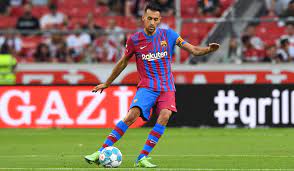Welcome to the 3rd Part of the article “Midfielders in Football – Analyze the Best Player’s Profile”. In the 1st Part, I presented The Sweeper Goalkeeper, and in the 2nd Part The central defenders and full backs. In the whole article, I will try to present the ideal player’s profile in each position for a team that wishes to play positional play football. For the purpose of offering information more clearly, I will upload the article in 4 parts.
In the 3rd part, I will present the positions of the 3 midfielders in football.


Upgrade your coaching skills with FootballCoach365 Premium! Get expert insights, video tutorials, tactical playbooks, training sessions, and more. Elevate your game – subscribe today.
Elevate Your Coaching Game with FootballCoach365 Premium Subscription!
- 30-Minute Online Session with Our Expert Coach
- “Ask Me Anything” Option
- Premium Exclusive Content
- Complimentary Copy of “How to Train Positional Play” for Free
The defensive midfielder – The pivot
Typically, the player in this role is perceived as someone with limited technical skills. However, the teams who wish to implement a positional play, for this role, use players technically very well. Additionally, the pivot should be probably the player who can read the game better than anyone. To have space awareness. Be equally good in defense but also be able to circulate the ball with speed and accuracy under pressure.

In the last decade, one of the best players in the specific position, who has changed the way we see defensive midfielders, is Sergio Busquets. Some of his best moments are those where he does not even touch the ball. He is able to create space for his teammates, drag opposition, and use minimum touches.
The pivot is regularly asked to drop back either between the center backs or to the side and create a back 3. La Salida Lavolpiana is a way to build up using 3 at the back. Pep Guardiola’s Barcelona from 2008 to 2012 reborn the specific concept.
The defensive midfielder can have a different name based on his duties. “Magister“, “Mestro“, “Controller” and “Pivot” are some of them.
The defensive midfielder is a position in between the defensive line and the midfield. The player does not have the extreme pressure that the defenders have and is not typically surrounded by opponents who have a great ability to mark. Of the 3 midfielders in football (#6, #8, and #10), the pivot is responsible to give the proper tempo in the game.
Characteristics of the ideal player’s profile
- High technical skills (especially in passing and receiving)
- Ability to use both feet
- Feel comfortable dropping back into the defensive line
- Understand the space and time
- Feel comfortable playing with risk under high pressure
Main roles of the ideal player’s profile
- Controller of the game
- Become a defender in build-up (create a back 3)
- Cover the central defenders in the defensive line when they get out wide to press
- Be the first defender when the ball is lost in the center
- Always be the Free man
The central midfielder – the second controller
To have a clear picture of what we mean by the terms “box to box” – “the second controller”, see below a list with, in my opinion, the best midfielders in football in the specific role for the last 20 years.
- Xavi
- Ilkay Gündoğan (even though the last year Guardiola transferred him to a more advanced position on the pitch)
- Cesc Fabregas
Let’s take Gündoğan as an example. This is a position of much tactical flexibility. This player typically is asked to act as a traditional playmaker but also to make more forward and key passes. In simple words, to push the game forward more regularly. Ilkay Gündoğan is a player who alters between controlling the ball in the central midfield position and in a deeper position.
The player in that position should be able to “feel” the passing and receiving procedure. In many occasions, he will see players free in a more advanced position on the pitch. That does not mean he should pass to them because they may not have immediate support and the ball has many chances to be lost.
The Drop Back movement
Many teams who adopt a high pressing behavior will mark the opponent’s pivot. In such a situation, the ball circulation in the initial stage is difficult. That will trigger the drop-back movements from the center midfield. He will act like a 2ns controller and will drop back to offer an additional passing option. This will create problems for the opponent as they need to change the way they press.
Speaking in Positional Play terms, the movement of the central midfielder to the back line aims to create a numerical or positional advantage. The movement will create automatically a +1 player. In case the opponent pushes a player forward to mark him or moves players from up front to the back, this will create space for the defenders or the pivot and this will be a positional advantage.
Additionally, the movement of the 2nd controller to the back will leave more space for the more advantageous midfielder up front. It is this foresight and planned approach to passing that completes a successful playmaker and not just the technical skill to pass well.
See below the best moments of Ikay from the 2020 – 2021 season from the official Manchester City Youtube channel. Ilkay is considered to be one of the best midfielders in football for the last few years.
Characteristics of the ideal player’s profile
- High technical skills (especially in passing and receiving)
- Ability to use both feet
- Ability in driving with the ball forward
- Feel comfortable dropping back as a 2nd controller
- Understand the space and time
- Feel comfortable playing between the lines
- A planned approach to passing
Main roles of the ideal player’s profile
- Become a 2nd Controller when is needed
- Defend zonally next to the pivot
- Always be the Free man
- Produce assist or 2nd assists
The box to Box or Attacking Midfielder
The relationship between the midfield three is very important for the overall successful implementation of a game model. Their contribution is even more important for teams who wish to implement a positional play model based on ball possession.
For a 4 – 2 – 3 – 1 formation, with two deeper midfielders and one more advanced, this player is given more space freedom. On the other hand, if the midfield has one controller and two advanced midfielders, in a 4 – 3 – 3, then a new set of requirements is needed.
The partnership between the advanced players and the pivot is:
- Creating superiorities (numerical and positional) and
- Nonverbal connection as to understand movements without the ball.
The quick thinking of the midfield is often key for the protection of the back line. The advanced players must be in a position to identify when to push out of the block to press to recover the ball and when to stick together with the rest of the block. There is a lot of unspoken communication between these players that only comes through the experience of playing together.
For these three midfield roles, it is easy to point out Busquets, Xavi, and Iniesta. They are probably the most completed midfield trio in modern football history. Anyone who wants to implement a positional play football based on possession will say “These are the player’s profiles I need”. Even though this is ideal, we need to know that it’s only one solution. A coach must analyze his player’s abilities and the team’s level in regard to possession and decide what player’s profiles he needs.
Kevin De Bruyne – The best-attacking midfielder
At the age of 31, Kevin De Bruyne had one of his most mature seasons with Manchester City. He was pivotal in many games for his team. On the last day of the 2021 – 2022 Premier League, in the title’s game, and while the game was 2 – 2 and City needed one goal to win the league, De Bruyne procedure a magical moment. Watch below the highlights of Manchester City – Aston Villa from the team’s official Youtube channel. Kevin’s moment on 1:39.
Characteristics of the ideal player’s profile
- Exceptional technical skills (driving with the ball, dribbling 1 v 1, shooting, passing, and receiving)
- Ability to use both feet
- Understand the space and time
- Move with the ball
- Understand the meaning of Positional Superiority
- Feel comfortable playing between the lines
Main roles of the ideal player’s profile
- Become 2nd Center Forward when is needed
- Defend zonally next to the forward (4 – 4 – 2) or the midfielders (4 – 5 – 1)
- Always be the Free man – Third man
- Produce assist or 2nd assists
- Scorer
Conclusion for midfielders in football
In all 3 roles, there is a level of technical ability expected that results in the players being able to play confidently in tight zones. For the best profile for a midfielder, it is essential to always include the technical characteristics.
Rondos and positional games in training will have a positive impact on these 3 players. They need to understand the details of passing and receiving, ball circulation, and to have the ability to always make movements without the ball, to create and take advantage of free spaces.
Any coach who wants to implement a positional play model needs to have exceptional midfielders. Whatever type of game (direct, possessional, counter-attacking, etc.) the need for elite players in the midfield with specific characteristics that fit the game model is mandatory. The best profile for a midfielder is subject to each coach’s personal opinion based on his game model, but some basic characteristics should always appear.
In any formation or way of play, midfielders in football are essential to the way a team performs.
We would like to hear your opinion!!! Leave your comment below


